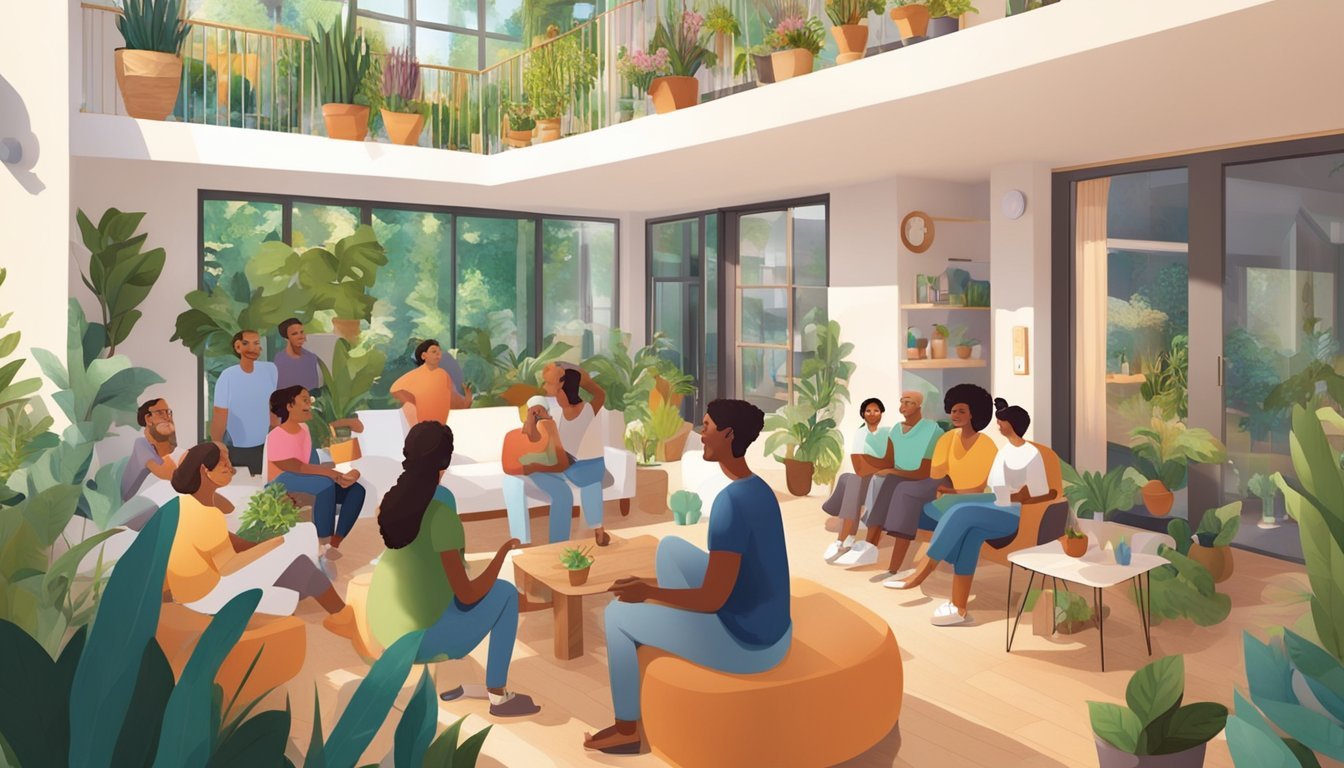Free Land for Co-Housing Projects
Opportunities and Benefits Explained
Seeking free land for co-housing projects can significantly ease the financial burden for those interested in developing shared living spaces. Offering free land not only reduces initial investment costs but also fosters the growth of sustainable, interconnected communities. From eco-friendly designs to mixed-use developments, these projects emphasize community living while promoting environmentally responsible practices.
Shared living spaces have gained popularity as they address various social and environmental concerns. The rise of cohousing showcases a shift towards more collective lifestyles, where resources are pooled, and social relationships are strengthened. These initiatives encourage multigenerational living and provide strategically planned car-free zones and communal areas, enhancing neighborhood interaction.
By embracing such models, individuals and families can experience a more connected and resource-efficient way of living. Developers, local governments, and community leaders worldwide recognize the potential of co-housing projects, providing support in the form of land grants or subsidies to stimulate these collaborative endeavors.
Understanding Co-Housing
Co-housing is a collaborative housing model where residents typically live in private homes but share communal spaces and responsibilities. It is designed to foster a sense of community and cooperation among its members.
History of Co-Housing
Co-housing originated in Denmark in the 1960s as a response to the growing desire for stronger community connections in residential areas. The concept was popularized by architects Charles Durrett and Kathryn McCamant, who introduced it to the United States in the 1980s.
Early co-housing communities were built to address urban loneliness and provide a more supportive living environment. These communities often featured shared facilities such as kitchens, dining halls, and recreational areas. Over time, the model has spread globally, adopting various forms to suit different cultural and social contexts.
Principles and Values
Co-housing communities are built on principles of mutual support, sustainability, and shared decision-making. Residents actively participate in the planning and management of their community, which can include setting rules, organizing communal activities, and maintaining shared spaces.
Values such as environmental stewardship, social interaction, and economic efficiency are central to co-housing. By sharing resources and responsibilities, residents can reduce their environmental impact, foster closer relationships, and lower living costs.
Key Principles:
Community Participation: Regular meetings and collaborative decision-making.
Shared Resources: Common facilities and tools.
Environmental Sustainability: Energy-efficient designs and green spaces.
Co-Housing Vs. Traditional Housing
Co-housing differs significantly from traditional housing in its emphasis on community and shared living. In traditional housing, individuals and families typically live in isolated units with limited interaction with neighbors.
In contrast, co-housing residents engage in communal activities and share facilities like laundry rooms, workshops, and gardens. This setup encourages frequent social interaction and mutual support, resulting in a more interconnected and cooperative living environment.
Additionally, the financial model of co-housing often involves shared costs for communal amenities and maintenance, which can be more cost-effective than traditional housing arrangements. Co-housing creates a balance between privacy in individual homes and the benefits of a close-knit community.
The Benefits of Shared Living
Shared living offers numerous benefits, including fostering social connections, providing economic advantages, and enhancing environmental sustainability. These communal living arrangements make it easier to address loneliness, offer affordability, and contribute to greener living.
Addressing Loneliness and Fostering Connections
Shared living spaces naturally bring people together. By sharing communal areas such as kitchens, living rooms, and coworking spaces, residents interact more frequently, building strong bonds and a sense of community.
These interactions can significantly reduce feelings of loneliness. This setup encourages social activities, shared meals, and collaborative projects that help create meaningful relationships.
Moreover, living in close proximity with a supportive community can improve mental health and general well-being. Shared spaces like fitness centers and rooftop terraces provide opportunities for group activities and social engagement.
Economic Advantages
Shared living can offer significant economic benefits. By sharing amenities and communal spaces, residents can enjoy high-quality facilities that might otherwise be unaffordable. For example, co-living arrangements often include fitness centers and coworking areas.
Residents save money by sharing maintenance costs, utilities, and other expenses. This makes luxury living more accessible and can provide a more affordable housing option, especially in urban areas where the cost of living is high.
Shared living also creates opportunities for cost-sharing on essentials such as groceries and transportation, further reducing individual expenses.
Environmental Sustainability
Co-housing projects promote environmental sustainability by efficiently using resources. By living together in a shared space, residents reduce their overall consumption of energy and materials. This includes sharing appliances, heating, and cooling systems, leading to less waste and lower carbon footprints.
Communal living also encourages sustainable practices like recycling, composting, and using green technologies. Many co-housing communities integrate features such as solar panels and rainwater harvesting systems.
Shared gardens and green spaces can enhance urban biodiversity and provide residents with locally grown food, reducing the need for transportation and packaging.
Shared housing arrangements contribute to building more sustainable and interconnected communities, offering a holistic approach to living green.
Planning and Design of Co-Living Spaces
Designing co-living spaces requires a thorough planning process to balance communal living with privacy needs. Key considerations include the collaborative design process, architectural and interior features, and the distinction between common areas and private spaces.
Collaborative Design Process
The collaborative design process in co-living projects is essential. Architects and developers work closely with future residents to understand their needs and lifestyle preferences. This participatory approach ensures that the design reflects the community's vision.
Meetings and workshops facilitate discussions on layout, shared amenities, and personal spaces. Tools like mood boards and 3D models help visualize ideas. Input from all stakeholders fosters a sense of ownership and satisfaction. By including residents in the design process, spaces are tailored to enhance communal and individual experiences.
Architecture and Interior Considerations
Architectural and interior considerations are crucial in creating functional and inviting co-living environments. Flexibility in design allows spaces to adapt to various activities and residents' needs. Open floor plans with multi-purpose rooms support social interactions and activities.
Materials should be durable yet aesthetically pleasing. Sustainable options promote environmental responsibility. Lighting, acoustics, and ventilation are key factors for comfort. Incorporating natural elements like plants and gardens can improve well-being. Ergonomic furniture and effective space utilization contribute to a harmonious living environment.
Common Areas and Private Spaces
Balancing common areas and private spaces is vital for the success of co-living projects. Common areas, such as communal kitchens, dining rooms, and lounges, foster social interactions. These spaces should be accessible and comfortable, encouraging residents to engage and bond.
Private spaces, on the other hand, offer a retreat for personal time. Each resident typically has their own room or studio, complete with essential amenities like a bathroom and kitchenette. Ensuring privacy while maintaining connectivity to common areas is key. Good soundproofing and thoughtful layout design can enhance this balance.
Global Co-Housing Trends
Co-housing projects are gaining traction worldwide, with notable developments in North America and Europe, as well as emerging cultures in other regions. This section examines key trends and initiatives in shared living spaces across different parts of the world.
Co-Housing in North America
In North America, the rise of co-housing has been significantly influenced by the increasing cost of living and the desire for strong community bonds. Projects like Muir Commons in California and Capitol Hill Urban Cohousing in Seattle illustrate this trend.
Older generations are particularly drawn to co-housing for its potential to reduce isolation and create a supportive environment. Silver Sage Village in Boulder, Colorado, specifically caters to older adults, providing private homes with shared amenities such as dining and recreational spaces.
Americans are also exploring innovative funding models to make co-housing more accessible, including community land trusts and cooperative ownership structures. This allows for a more inclusive economic approach, ensuring that people from diverse backgrounds can participate.
European Co-Housing Initiatives
Europe has a rich history of co-housing, especially in countries like Denmark and Germany. The Vindmøllebakken project in Norway, designed around the "Gaining by Sharing" model, is a contemporary example of these long-held traditions, focusing on communal living and environmental sustainability.
In London, co-housing addresses urban density challenges and high housing costs. Copper Lane is a notable project where residents share resources and communal areas while maintaining private living spaces. This model fosters strong neighborhood relationships and efficient use of land.
Barcelona is another hotspot for co-housing, driven by innovative architectural designs and community-oriented philosophies. Projects here emphasize sustainability and social inclusion, often incorporating mixed-use elements that blend residential, commercial, and communal spaces.
Emerging Co-Housing Cultures Worldwide
Outside North America and Europe, co-housing is emerging in diverse cultural contexts. In Japan, shared living spaces are becoming popular among younger generations seeking affordable living solutions and community engagement in dense urban environments. Projects here often use minimalistic designs and emphasize harmony with nature.
In Latin America, co-housing initiatives are typically grassroots movements aimed at reducing socio-economic disparities. These projects often involve collaboration with local governments and NGOs to provide affordable, community-centered housing.
Across regions, co-housing developments are adapting to local cultural and economic conditions, demonstrating the versatility and appeal of shared living spaces globally. This adaptability is key to the growing acceptance and proliferation of co-housing projects.
Legal and Financial Framework
Navigating the legal and financial framework for co-housing projects involves understanding different ownership and renting models, zoning and urban planning policies, and financing strategies. Each of these elements plays a crucial role in the successful development of shared living spaces.
Ownership and Renting Models
Ownership and renting models for co-housing vary widely. Some projects adopt cooperative ownership, where members collectively own the property. Others use condominium structures, granting individual ownership of units with shared common areas.
Lease agreements can also be structured in unique ways. Long-term leases might involve lower monthly payments, creating stability for residents. A mix of ownership and renting helps cater to diverse financial capabilities, making co-housing accessible to more people.
The chosen model affects legal obligations. In cooperative models, members share responsibilities for maintenance and governance. Condominiums, meanwhile, might require a formal homeowners association. These arrangements must be clearly defined to avoid disputes.
Zoning and Urban Planning Policies
Co-housing projects must comply with stringent zoning and urban planning policies. Urban planners play a significant role in this by designating areas where such developments are permissible. The London Plan's Policy H16, for example, provides guidelines for large-scale purpose-built shared living.
Zoning laws influence the density and layout of co-housing spaces. High-density urban areas may have different requirements compared to suburban or rural areas. Real estate prices in the zone can also impact project feasibility.
Environmental regulations might impose additional requirements, like green space provisions or sustainable building practices. Developers must work closely with authorities to navigate these complex regulations, ensuring that their projects meet all legal standards.
Financing Co-Housing Projects
Financing co-housing projects requires a mix of traditional and innovative methods. Community-led housing groups may receive support from national networks, like the National Community Land Trust Network in the UK, which aids in developing co-operatives and land trusts.
Crowdfunding and cooperative banks that focus on ethical finance are increasingly popular. These institutions offer loans and financial products aligned with the values of social inclusion and community engagement.
Government grants and subsidies might be available, especially for projects that address the housing crisis. Developers can also explore partnerships with local authorities to secure funding and accelerate project timelines. Detailed financial planning is essential to balance costs and ensure the project's sustainability.
The Role of Communities and Residents
In co-housing projects, the involvement of communities and residents plays a crucial role in fostering vibrant, supportive, and inclusive living spaces. Key aspects include building bonds, shared management, and promoting multi-generational interactions.
Building Community Bonds
Residents in co-housing projects create close-knit communities by actively participating in shared activities and communal spaces. These opportunities for socialization often revolve around dining areas, recreational rooms, and outdoor spaces.
Mutual support systems develop naturally in such environments, enabling residents to rely on each other for help with daily tasks or emergencies. This sense of community can lead to stronger relationships among residents, enhancing their overall well-being.
Collaborative events such as potlucks, gardening projects, and holiday celebrations further strengthen these bonds, providing continuous opportunities for interaction and connection.
Shared Responsibilities and Management
Co-housing emphasizes collective management, where residents take on shared responsibilities to maintain and manage their communal spaces. Tasks such as cleaning, gardening, and decision-making are often divided among community members through structured systems or rotating schedules.
This shared responsibility fosters a sense of ownership and accountability. It encourages residents to contribute meaningfully to the upkeep of their living environment.
Decision-making processes often include regular meetings where residents discuss and implement policies, ensuring everyone's voice is heard. This democratic approach to management helps in maintaining harmony and addressing issues promptly.
Inclusive and Multi-Generational Living
Co-housing projects promote inclusive living by integrating residents of different ages, cultural backgrounds, and social circumstances. This multi-generational approach allows for the exchange of knowledge and experiences between younger and older residents.
Elderly residents benefit from the care and interaction provided by younger generations, while children gain valuable insights and mentorship from their older neighbors. This dynamic helps build a supportive environment where life skills and care are exchanged freely.
Inclusivity is also enhanced through accessible design features, ensuring that homes and communal areas are suitable for residents with varying levels of mobility. This thoughtful design planning helps create a living space that is welcoming and comfortable for everyone.
Case Studies and Successful Models
Examining cases of successful co-housing projects reveals key principles and achievements that define modern communal living spaces. Insights from diverse projects provide a comprehensive view of how collective living enhances community engagement and optimizes resources.
Mokrin House: A Paradigm of Modern Co-Living
Mokrin House, located in Serbia, exemplifies the integration of co-working and co-living. This innovative space caters to digital nomads and remote workers, providing private rooms alongside shared amenities. The design promotes collaboration and community through communal kitchens, leisure areas, and workspaces.
Residents benefit from events, workshops, and social activities, fostering networking and personal growth. Mokrin House stands out for its successful blend of modern living with an emphasis on sustainability and quality of life. This model showcases how architecture can encourage social interaction and professional productivity.
ArchDaily Featured Co-Housing Projects
Several projects highlighted by ArchDaily illustrate diverse approaches to co-housing. Sættedammen in Denmark is a notable example, featuring 35 families in private homes with shared communal spaces. These areas include dining halls and group activity spaces, enhancing social connections among residents.
Vindmøllebakken in Norway, designed by Helen & Hard, follows a "Gaining by Sharing" model. This project includes 40 co-living units and emphasizes sustainable living and community engagement. By integrating shared facilities, these projects enhance collective living while respecting individual privacy.
The WeLive Experiment: New York's Urban Co-Living
In New York, WeLive’s urban co-living model redefines residential living in densely populated areas. These spaces, part of the WeWork family, offer fully furnished apartments with shared common areas like kitchens, lounges, and fitness centers.
WeLive's flexible lease terms and multiple social events appeal to young professionals and urban dwellers seeking community without sacrificing privacy. This project underscores the potential of co-living in easing urban housing pressures while fostering vibrant, interactive communities. WeLive demonstrates how well-designed shared living environments can thrive in a bustling metropolis.
Overcoming Challenges in Co-Housing
Addressing the unique challenges in co-housing requires careful consideration of privacy, effective integration of technology, and striking a balance between individual preferences and community needs.
Managing Privacy and Shared Spaces
Privacy is a significant concern in co-housing communities. Effective design solutions can help alleviate this challenge. Incorporating private retreats within living units allows residents to enjoy solitude when desired.
Communal spaces should be designed to facilitate interaction while respecting personal boundaries. Flexible scheduling and clear rules for using shared spaces can help manage conflicts. Residents should have a say in these rules, ensuring their needs and preferences are respected. Balancing these elements is crucial to fostering a harmonious co-living environment.
Evolving Co-Housing with Technology
Integrating technology can enhance co-housing experiences by offering increased convenience and security. Smart home systems can automate shared resource management, such as energy usage and maintenance tasks, boosting efficiency.
Digital platforms facilitate communication and coordination among residents, ensuring everyone stays informed about communal activities and responsibilities. Investing in security technologies, like surveillance cameras and access control systems, can help maintain a safe environment, addressing privacy concerns. Embracing technology is key to modernizing co-housing communities.
Balancing Individual and Collective Needs
Striking a balance between individual desires and community requirements is essential for co-housing success. Regular community meetings enable residents to voice their opinions and participate in decision-making processes. Establishing a culture of mutual respect and understanding helps manage diverse expectations.
Providing a mix of private and communal amenities ensures all residents find their needs met. Offering choice and flexibility in living arrangements helps accommodate varying lifestyles. Encouraging participation in communal activities strengthens bonds among residents, fostering a sense of belonging while respecting individual preferences.






